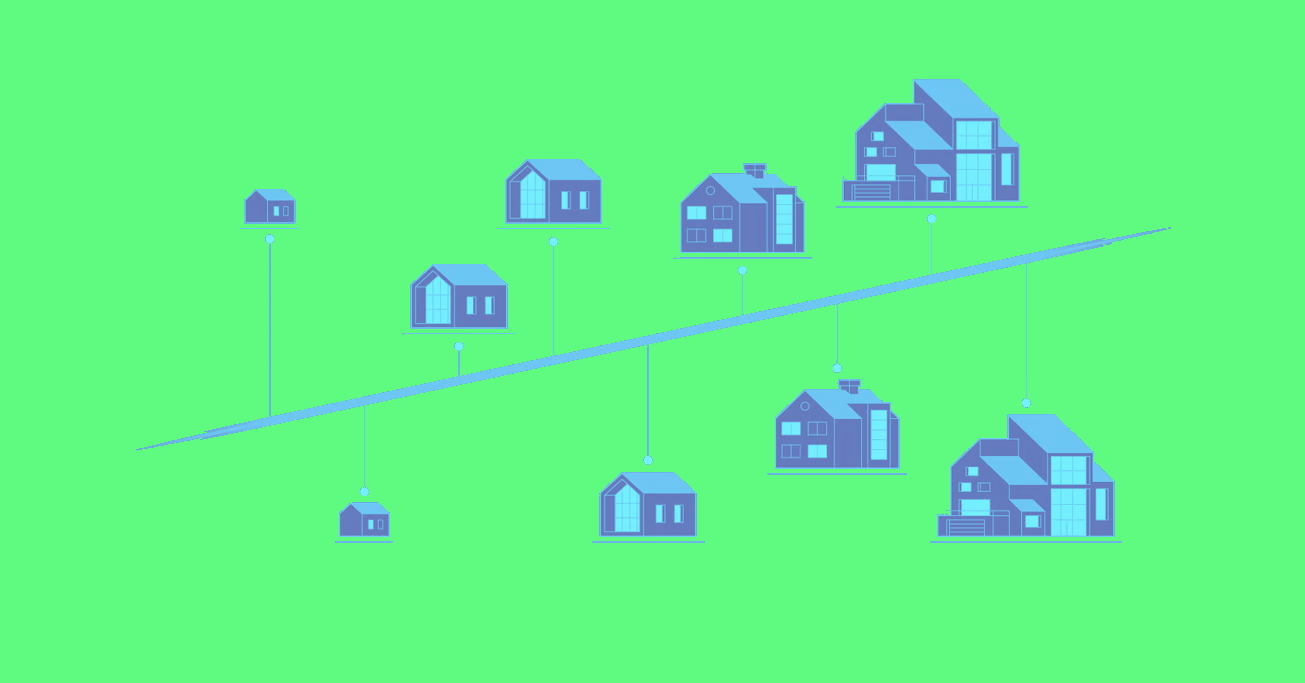The principle of progression stands as a cornerstone in understanding property values and the dynamics of the real estate market. This concept, widely recognized by real estate appraisers, has a significant influence on how properties are valued and how investors make decisions. It suggests that the value of a property can increase when it’s surrounded by higher-value properties, creating a ripple effect in neighborhoods and communities.
Real estate professionals and investors rely on the principle of progression, along with its counterpart, the principle of regression, to analyze market trends and make informed decisions. These principles help to explain why property values in certain areas may rise or fall over time. By understanding how progression and regression work in real estate, individuals can gain valuable insights into market dynamics, investment opportunities, and the factors that shape property values in different locations.
Understanding the Principle of Progression
Definition and concept
The principle of progression in real estate is a fundamental concept that has a significant influence on property values. This principle states that the value of a property can increase when it is surrounded by higher-valued properties. In essence, it suggests that a house’s worth can be positively affected by the presence of more expensive homes in the same neighborhood or locality.
Real estate appraisers and professionals widely recognize this principle as a key factor in determining property values. It illustrates the economic concept of positive externality, where an object or individual benefits from the characteristics or actions of another. In the context of real estate, this means that a lower-end property can experience an increase in value due to its proximity to higher-end properties.
How it affects property values
The principle of progression has a substantial impact on property values in several ways. When a neighborhood has a mix of properties with varying values, the lower-priced homes tend to benefit from the presence of more expensive ones. This effect creates a ripple in the real estate market, potentially raising the overall value of properties in the area.
Several factors contribute to this phenomenon:
- Neighborhood esthetics: Higher-valued properties often have better maintenance and curb appeal, which can enhance the overall look of the neighborhood.
- Low crime rates: Upscale neighborhoods typically have lower crime rates, making the entire area more desirable.
- Quality schools: Areas with higher-priced homes often have access to better-ranked schools, which can increase property values.
- Amenities and facilities: The presence of retail stores, grocery shops, and recreational facilities can make a neighborhood more attractive.
- Higher median income: Areas with more expensive homes usually have residents with higher incomes, which can lead to better community investment.
These factors work together to create a positive environment that can boost the value of all properties in the vicinity, including those that might be considered less valuable on their own.
Examples in real estate markets
To better understand how the principle of progression works in practice, consider the following examples:
- Neighborhood expansion: A homeowner lives in a modest house in a well-established neighborhood. An adjacent piece of land is purchased and developed into a luxury home community with high-end properties, a golf course, and green spaces. As a result, the value of the existing homes in the area, including the modest house, is likely to increase significantly.
- Up-and-coming areas: A buyer purchases a smaller home in a neighborhood surrounded by more expensive properties. Over time, the value of this home is likely to appreciate more than a larger house in an area with decreasing property values.
- Gentrification: When a previously less desirable urban area experiences an influx of higher-income residents and new development, property values in the entire neighborhood tend to rise. Studies have shown that proximity to gentrified areas can increase housing values by approximately 6-8%.
- Spillover effects: Research has indicated that properties within two miles of a homeowners association (HOA) can experience a premium of about 8.5% in value, demonstrating how the principle of progression can extend beyond immediate neighbors.
These examples illustrate how the principle of progression can have a tangible impact on real estate markets and individual property values. By understanding this concept, investors and homebuyers can make more informed decisions when choosing properties, potentially benefiting from future value appreciation due to the surrounding higher-valued properties.
Exploring the Principle of Regression
Definition and concept
The principle of regression in real estate is the counterpart to the principle of progression. It states that properties located in areas that are declining or deteriorating will decrease in value. This concept is based on the idea that as an area declines, the demand for properties in that area will decrease, leading to a reduction in property values. In simpler terms, if a home is surrounded by lower-priced properties, its value may be negatively impacted.
Real estate appraisers and professionals widely recognize this principle as a key factor in determining property values. It illustrates the economic concept of negative externality, where an object or individual is adversely affected by the characteristics or actions of another. In the context of real estate, this means that a higher-end property can experience a decrease in value due to its proximity to lower-end properties.
Impact on property values
The principle of regression has a substantial impact on property values in several ways:
- Neighborhood esthetics: Lower-valued properties may have less maintenance and curb appeal, which can detract from the overall look of the neighborhood.
- Market perception: Areas with a higher concentration of lower-priced properties may be perceived as less desirable, affecting the value of all properties in the vicinity.
- Appraisal considerations: Real estate appraisers take into account the surrounding properties when determining a home’s value. If a property is significantly more valuable than its neighbors, it may be appraised at a lower value due to regression.
- Investment potential: Properties in areas experiencing regression may have limited appreciation potential, making them less attractive to investors.
- Buyer preferences: Potential buyers may be hesitant to purchase a high-end property in an area surrounded by lower-valued homes, leading to reduced demand and lower prices.
Real-world examples
To better understand how the principle of regression works in practice, consider the following examples:
- MC Hammer’s mansion: In the early 1990s, rapper MC Hammer purchased a USD 20 million mansion in Fremont, California. However, the surrounding community did not support such a high property value. When he had to sell the home, he couldn’t recoup the USD 20 million investment, demonstrating how the principle of regression affected the property’s value.
- Overimprovement: A homeowner purchases a house in a neighborhood where the average home value is USD 300,000. They extensively remodel and expand the property, adding two bedrooms and another bathroom. While a similar five-bedroom, two-bathroom house might sell for USD 450,000 in another area, this particular house might only reach USD 425,000 due to regression caused by the surrounding lower-valued properties.
- Airport proximity: A property located near an airport may experience regression due to noise pollution and decreased desirability, even if the house itself is of high quality.
- Neighborhood expansion: Consider a scenario where a homeowner’s property value initially increases due to a planned luxury home community nearby. However, if the development is halted or changed to include lower-priced homes, the principle of regression may come into play, potentially decreasing the property’s value.
Understanding the principle of regression is crucial for real estate professionals, investors, and homebuyers. It highlights the importance of considering the neighborhood and surrounding properties when evaluating a property’s value. By recognizing the potential impact of regression, individuals can make more informed decisions in the real estate market and avoid overpaying for properties that may not appreciate as much in the future.
Applying Progression and Regression in Real Estate Investing
Understanding the principles of progression and regression is crucial for real estate investors to make informed decisions and maximize their returns. These concepts can help investors identify opportunities, mitigate risks, and develop effective strategies in the dynamic real estate market.
Identifying opportunities
Real estate investors can leverage the principle of progression to identify potential investment opportunities. By recognizing areas where property values are likely to increase due to surrounding higher-valued properties, investors can make strategic decisions. For example, purchasing a property in a neighborhood where new luxury developments are planned can lead to significant appreciation over time.
Investors should conduct thorough market research to identify areas experiencing positive changes, such as infrastructure improvements, commercial developments, or gentrification. These factors can contribute to the progression of property values in the area. Additionally, analyzing appreciation trends can help investors spot properties that have consistently appreciated despite the presence of lower-priced properties nearby.
It’s important to note that opportunities can arise in different phases of the real estate cycle. During the recovery phase, investors may find bargain-priced properties in varying states of distress, which can be repositioned as the market improves. In the expansion phase, value-add strategies can be particularly effective, as investors can acquire properties with current deficiencies at substantial discounts and reposition them rapidly.
Mitigating risks
While the principles of progression and regression offer opportunities, they also present risks that investors must carefully consider and mitigate. One of the primary risks is the potential for regression, where a property’s value may decrease due to surrounding lower-valued properties or declining neighborhood conditions.
To mitigate these risks, investors should:
- Conduct thorough due diligence: Perform comprehensive property inspections and assessments to identify potential issues and evaluate the overall condition of the property.
- Diversify investments: Spread investments across different property types and geographical locations to minimize the impact of market fluctuations in any one sector or area.
- Implement sound property management practices: Develop rigorous tenant screening processes and maintain properties proactively to prevent costly repairs and attract high-quality tenants.
- Utilize appropriate insurance coverage: Protect investments with comprehensive property and liability insurance to safeguard against potential damage, loss, or legal claims.
- Stay informed and adaptable: Monitor market trends and indicators, and be prepared to adjust strategies based on changing circumstances and new information.
Strategies for investors
Investors can employ various strategies to capitalize on the principles of progression and regression in real estate:
- Buy and hold: Acquire properties in areas showing signs of progression and hold them for long-term appreciation. This strategy can be particularly effective when investing in core properties during the recovery phase of the real estate cycle.
- Value-add: Purchase properties with current deficiencies at discounts and invest in capital improvements to reposition them. This strategy can be highly profitable during the expansion phase of the market cycle.
- Development: In markets experiencing strong progression, investors may consider developing or redeveloping properties to capitalize on rising demand and potentially set new market highs for rental rates.
- Opportunistic investing: During periods of regression or market downturns, investors can acquire distressed assets at steep discounts with the intention of repositioning them when market conditions improve.
- Core-plus investing: For investors seeking lower levels of risk, acquiring core-plus properties in stable or improving areas can provide steady cash flow and potential for appreciation.
By understanding and applying the principles of progression and regression, real estate investors can make more informed decisions, identify promising opportunities, and develop strategies that align with their investment goals and risk tolerance. It’s essential to remain vigilant, adapt to changing market conditions, and continuously reassess investment strategies to maximize returns and minimize risks in the dynamic real estate market.
Conclusion
The principles of progression and regression have a significant influence on the real estate market, shaping property values and investment strategies. These concepts provide valuable insights to help investors, homebuyers, and real estate professionals make informed decisions. By understanding how surrounding properties can affect a property’s value, individuals can better navigate the complex world of real estate and identify promising opportunities.
To wrap up, the principles of progression and regression are essential tools to analyze market trends and make smart investment choices. They highlight the importance of considering the neighborhood and surrounding properties when evaluating a property’s potential. By applying these principles, investors can develop effective strategies to maximize returns and minimize risks in the ever-changing real estate landscape. Remember, staying informed and adaptable is key to success in this dynamic market.
FAQs
- What do the terms regression and progression mean in real estate?
- In real estate, the principle of regression suggests that the value of a high-end property can decrease if it is surrounded by lower-valued properties. Conversely, the principle of progression indicates that the value of a property can increase when higher-valued properties are developed in the vicinity.
- Can you explain the principle of regression in real estate?
- The principle of regression posits that the value of a more expensive property will decline when it is surrounded by less expensive homes. For example, if a home valued at USD 500,000 is located among homes worth USD 100,000, the value of the more expensive home is likely to decrease.
- What is the principle of progression in real estate?
- The principle of progression in real estate is based on the idea that the value of a property increases when more valuable properties are built nearby. This concept is often summarized by the saying, “A rising tide lifts all boats,” indicating that an area’s general increase in value benefits all properties within it.
- What does the principle of increasing and decreasing returns mean in real estate?
- This principle states that initially, adding more of a single factor of production, while keeping other factors constant, will increase returns. However, continuing to add more of that factor will eventually lead to diminishing returns, meaning the additional benefits gained from using more of that factor will decrease.
Wonderful San Jose Homes for Sale
2
3
4
5
6
7
8
9
10
11
12
13
14
15
16
17
18
19
20
21
22
23
24
25





